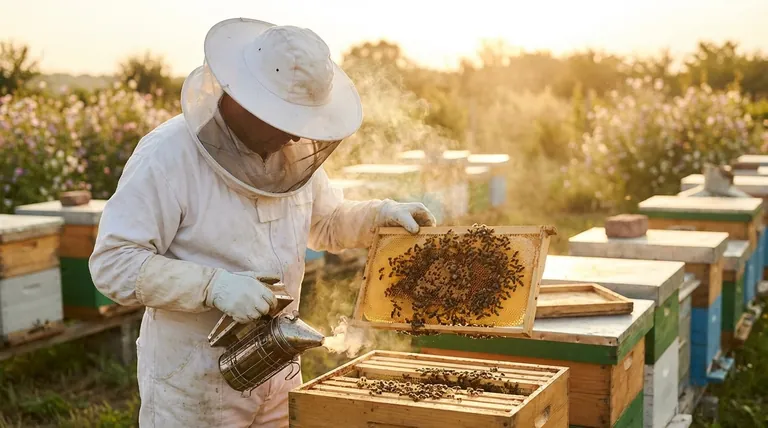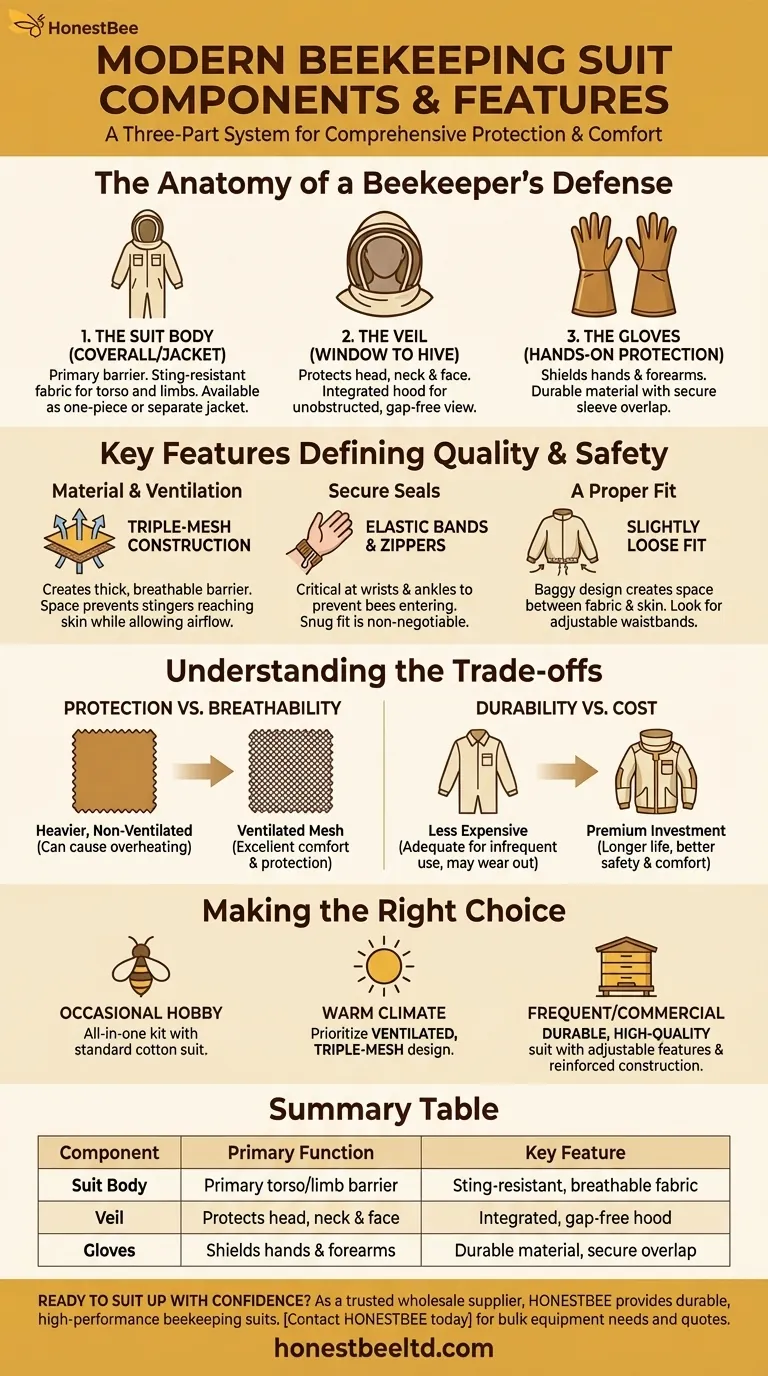At its core, a modern beekeeping suit is a three-part system designed for comprehensive protection. It consists of a full-body garment (either a one-piece coverall or a separate jacket), a hooded veil to shield the head and neck, and durable gloves to protect the hands. The effectiveness of this system hinges on creating a complete seal, with elastic cuffs at the wrists and ankles being absolutely critical to prevent bees from crawling inside.
The essential components of a bee suit are straightforward, but the real difference between adequate and excellent protection lies in the details. Your goal is to find a suit that balances total impermeability to stings with the comfort and ventilation needed to work calmly and effectively.

The Anatomy of a Beekeeper's Defense
Understanding each component's specific function is the first step toward appreciating how the entire system works to keep you safe and focused on your bees.
The Suit Body (Coverall or Jacket)
The main garment provides the bulk of your protection. It serves as the primary barrier between your body and the bees.
Whether you choose a one-piece coverall for maximum coverage or a separate jacket for convenience, the material's job is to be sting-resistant.
The Veil (Your Window to the Hive)
The veil is arguably the most critical component for a beekeeper's confidence. It protects the sensitive areas of your face, neck, and head.
Modern suits integrate the veil directly into the hood, offering an unobstructed view of the hive while ensuring no gaps exist for bees to enter.
The Gloves (Hands-On Protection)
Your hands are in constant motion and closest to the bees during an inspection. Gloves must be tough enough to prevent stings yet flexible enough to allow for delicate work.
They are typically made of leather or other durable materials and extend up the forearm to overlap securely with the suit's sleeves.
Key Features That Define Quality and Safety
Beyond the basic components, specific design features determine a suit's effectiveness, comfort, and durability. These are the details you must pay close attention to.
Material and Ventilation
Modern high-quality suits often use a triple-mesh construction or other forms of aerated fabric.
This design creates a thick yet breathable barrier. The space itself prevents a bee's stinger from reaching your skin, while the mesh allows for crucial airflow, significantly improving comfort during hot weather.
Secure Seals and Entry Points
A bee suit is only as good as its weakest entry point. Elastic bands at the wrists and ankles are non-negotiable features.
These create a snug fit that prevents bees from crawling up your arms or legs. High-quality zippers with overlapping flaps provide additional security. Some suits also include boot covers for an extra layer of protection at the ankles.
The Importance of a Proper Fit
Your suit should fit well, but "well" means slightly loose, not tight. A baggy fit creates more space between the fabric and your skin, making it harder for a stinger to make contact.
Look for suits with adjustable features like elasticized waistbands or drawstrings. These allow you to customize the fit for both safety and comfort during movement.
Understanding the Trade-offs
Choosing the right suit involves balancing competing priorities. There is no single "best" suit for everyone; there is only the best suit for your specific needs.
Protection vs. Breathability
Heavier, non-ventilated cotton suits may feel psychologically more secure, but they can become oppressively hot, leading to fatigue and mistakes.
Ventilated mesh suits, while offering excellent protection, rely on their thickness and design for safety. The key is to trust that the multi-layer mesh is just as effective while providing superior comfort.
Durability vs. Cost
A premium suit with reinforced seams, high-quality zippers, and durable mesh material is an investment. It will last longer and provide better long-term comfort and safety.
Less expensive suits can provide adequate protection for infrequent use, but they may wear out faster and often lack the ventilation features that make beekeeping more enjoyable.
Making the Right Choice for Your Needs
Select your gear based on your climate, the intensity of your beekeeping, and your personal comfort threshold.
- If your primary focus is occasional hobby beekeeping: An all-in-one kit with a standard cotton suit, veil, and gloves will provide the necessary protection to get started confidently.
- If your primary focus is beekeeping in a warm climate: Prioritize a suit with a ventilated, triple-mesh design to ensure comfort and prevent overheating during inspections.
- If your primary focus is frequent or commercial-level work: Invest in a durable, high-quality suit with adjustable features and reinforced construction for long-term reliability and safety.
Ultimately, your bee suit is a tool that enables you to work with confidence, and the right choice empowers you to be a calm and effective beekeeper.
Summary Table:
| Component | Primary Function | Key Feature |
|---|---|---|
| Suit Body (Coverall/Jacket) | Primary barrier for the torso and limbs | Sting-resistant, breathable fabric (e.g., triple-mesh) |
| Veil | Protects the head, neck, and face | Integrated hood design for an unobstructed, gap-free view |
| Gloves | Shields hands and forearms during hive work | Durable material (e.g., leather) with a secure sleeve overlap |
Ready to suit up with confidence?
As a trusted wholesale supplier to commercial apiaries and distributors, HONESTBEE provides durable, high-performance beekeeping suits designed for long-term safety and comfort. Our gear helps you and your team work more efficiently and calmly.
Contact HONESTBEE today to discuss your bulk equipment needs and get a quote tailored to your operation.
Visual Guide

Related Products
- Cotton Beekeeping Suit and Round Hat with Veil Bee Keeper Protective Gear
- White Beekeeping Protective Suit and Hat with Fencing Veil for Beekeepers
- Heavy Duty Cowboy Beekeeper Hat with Visibility Veil Outdoor Professional Beekeeping Protective Gear
- Beekeeper Cowboy Hat and Veil for Beekeeping
- Beekeeping Gloves Goatskin Leather with Long Cotton Sleeve for Beekeepers
People Also Ask
- What factors should be considered when choosing a beekeeping suit? Balance Safety, Comfort & Performance
- Why is white the predominant color in bee suit designs? | Key to Hive Calm & Beekeeper Safety
- What should be considered regarding the color of beekeeping clothing? Ensure Your Safety and Keep Bees Calm
- Why is a jacket with a hat veil recommended for beekeepers? Essential Protection for Your Face and Neck
- What is recommended for beginners in beekeeping regarding protective clothing? A Complete Safety Guide for New Beekeepers



















